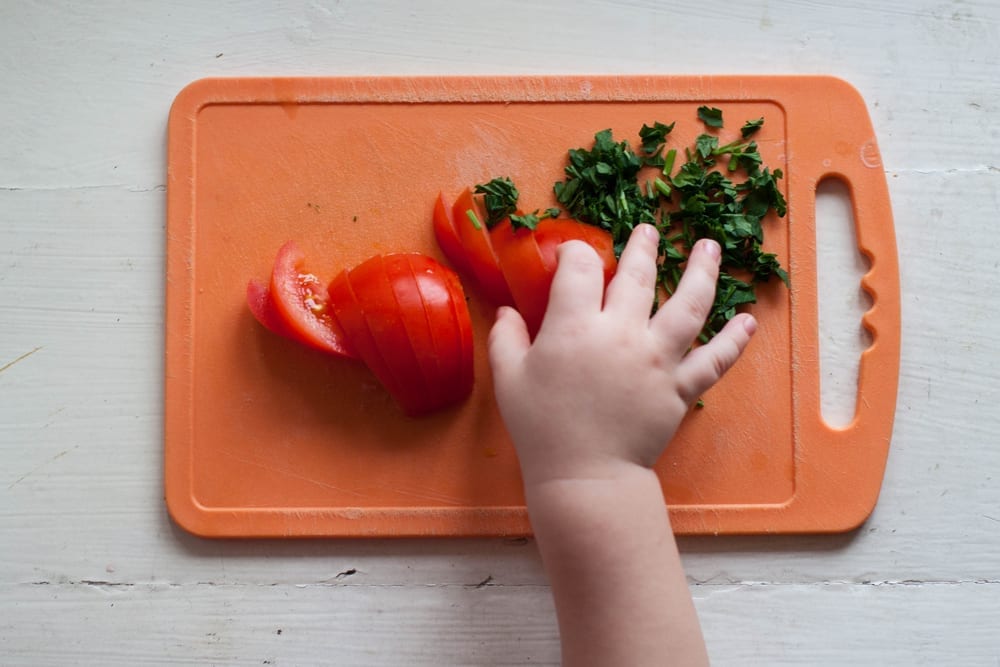What is baby led weaning?
Baby led weaning has risen in popularity over recent years with more and more parents adopting the approach. So what exactly is it?
Your baby can practice their motor skills by learning how to grab, handle and bring the food to their mouth. They can also explore the different textures, smells and tastes. Hopefully they will eventually learn to eat some on their own without the need for spoon feeding.
Unlike spoon feeding, your baby has the choice to pick up and explore all sorts of foods and – after playing with it – will learn to eat it.
Related: Compare the pros and cons of each weaning method here – Purees vs Baby led weaning.
Below we break down baby led weaning foods by age. We show which foods are the most appropriate for baby at each weaning stage, and which you should avoid altogether.
We hope it helps you along your baby led weaning journey.
At what age can you start Baby Led Weaning?
It’s important to wait until your baby is at least 6 months old before starting baby led weaning.
In the UK it’s advised to check with a doctor before starting any weaning before 6 months. Other countries may have different guidelines.
Related: When is the best time to wean baby? Arguments for and against early weaning.
If you start weaning earlier than 6 months, it’s recommended to start with just pureed foods at first.
After 6 months of age, your baby will need to feel comfortable doing these 3 main things before you begin baby led weaning:
- sit unaided and hold their head upright in a steady position
- have developed the fine motor skills to pick up food and put it in their mouth
- swallow food, rather than just chewing it and spitting it out
If your baby can do these things then you could be ready to begin baby led weaning.
Do I have to choose between baby led weaning and puree feeding?
No you don’t have to choose between puree feeding and baby led weaning, you can take a combination approach. Parents often feel that they must do one route or the other. However it’s fine to offer both purees and finger foods at the same time if you feel it’s best. That way your baby can get the benefits of both.
This is especially helpful if you’re concerned your baby is not eating enough with baby led weaning.
Over time they will get better at handling and eating finger foods. At this point you can then phase out the purees.
It can take a while for babies to successfully learn to eat food on their own. So supplementing their finger food explorations with some blended purees for a time, can enable them to get enough nutrition, while also getting the benefits of baby led weaning.
How do I get started with baby led weaning?
Keep baby’s milk feeds unchanged
When you begin weaning your baby’s milk feeds all remain unchanged. It’s important for baby to continue to get the nutrition she needs from her bottle or breastmilk.
Offer soft, mild finger foods as batons
Start baby led weaning by giving your baby soft foods, which are mild and easy to digest and then gradually introduce them to new textures and tastes. Cut first foods into slices and batons that are big enough for your baby to grasp and hold.
A good idea is to make them long enough to fit in your baby’s fist with a little bit sticking out for the to chew on. You can use your own index finger as a rough size guide for these batons.
Offer a variety of foods
Offer your baby a variety of foods over the week. Let her play with them, touch them and taste them. Try not to hurry her or encourage her to eat. Let her lead the way. Gradually introduce your baby to different tastes and textures.
By their first birthday they will be eating the same meals as the rest of the family.
Ready to begin? Here are some foods to offer baby at each weaning stage:
Baby Led Weaning First Foods 6 months

For those very first foods, start with fruits and vegetables that are mild in taste and light and easy for baby to digest.
Soft fruit and vegetable batons or slices make the perfect first food for baby to try. Easy to mash about with their gums and easy to digest.
Here are some foods you could start with:
Fruits:
- Apples – soft cooked apple slices
- Avocados
- Bananas
- Nectarine slices
- Peach slices – soft ripe peaches
- Pears – ripe slices or steamed pieces
- Plum slices – ripe slices or steamed pieces
Vegetables:
- Broccoli florets – steamed
- Carrots – steamed or boiled batons
- Cucumber batons – peeled
- Green beans – steamed or boiled
- Peas – cooked
- Squash and butternut squash – soft cooked pieces
- Sweet potato – peeled and cooked pieces
Grains:
- Rice
- Oatmeal
Baby Led Weaning Foods 6 – 8 months
Add a greater variety of foods for baby
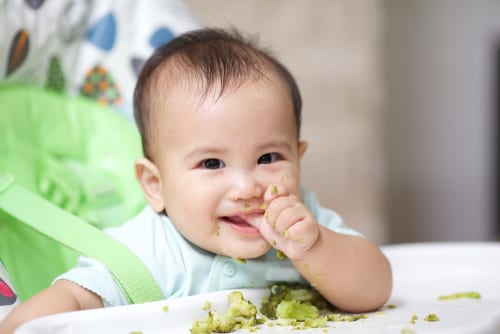
Once your baby has got used to their first soft fruit and veg, you can start introducing a wider variety of foods like some lean meats and fish.
Remember to always remove the skin off of vegetables (like courgettes) before offering them to baby. The skin of courgettes and aubergines can be quite acidic and can affect some babies’ stomachs.
Here are some foods baby can move onto trying as well as continuing to enjoy those listed earlier.
Fruits:
- Apricots
- Mango – ripe and soft pieces
- Nectarine slices – ripe
- Peach – ripe and soft
- Plums
Vegetables:
- Courgettes – peeled and cooked until soft
- Parsnips – peeled and cooked
- Pumpkin – soft cooked pieces
Meats & Fish:
(all cooked through until soft and tender)
- Chicken
- Turkey
- White fish (avoid larger fish and check thoroughly for bones)
Grains:
- Fingers of bread, pitta or toast
- Pasta pieces
- Barley
- Breadsticks
- Unsalted rice cakes
- Oatcakes
Baby Led Weaning Foods 8 – 10 months
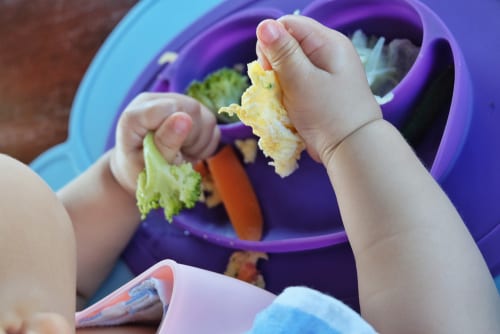
Your baby is now ready to try other meats and grains and can start eating combinations of food and try mini portions of family meals. They can use their fingers to start with. As they get older they can move onto trying to eat with a spoon or fork.
Here are some foods you can introduce along with all the foods they are already enjoying:
Fruits:
- Blueberries
- Cherries – halved and pipped
- Figs
- Grapes – halved
- Melon
- Papaya
Vegetables:
- Asparagus
- Aubergine (peeled)
- Beetroot
- Cauliflower
- Dried beans (cooked)
- Leeks
- Lentils
- Onions
- Potato (white)
- Turnip
Meats and Proteins
- Beef
- Eggs
- Pork
- Salmon
Grains:
- Quinoa
- Buckwheat
- Flax
- Khorasan wheat
- Millet
Dairy:
- Yogurt
- Cream cheese
- Cottage cheese
- Cheese sticks
Baby Led Weaning Foods 10-12 months
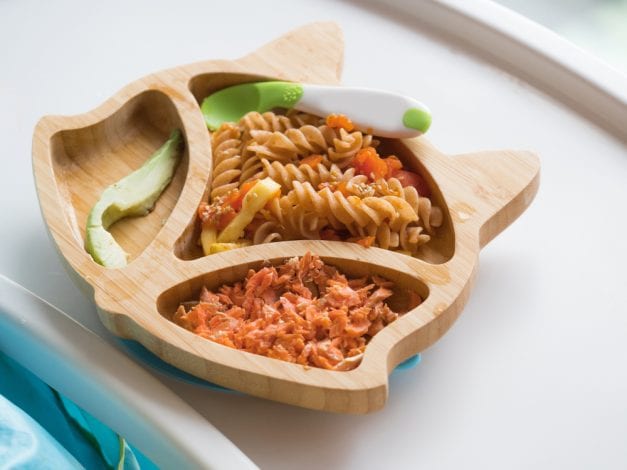
At this age you can start to try to give your baby more acidic fruits and heavier foods. Keep an eye on how they handle each new food to check that they aren’t sensitive to it.
You can now include a few extra foods:
Fruits:
- Strawberries
- Tomatoes
- Raspberries
- Kiwi
- Oranges
Vegetables
- Spinach
- Sweet corn
Baby Led Weaning 12 months and Onwards
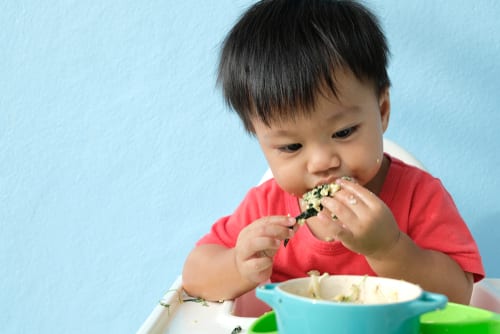
By the time your baby reaches his first birthday his taste explorations are complete and he can tuck into whatever you enjoy as a family.
Join our Baby Led Weaning Community
Ask any questions, share recipe ideas and connect with other parents weaning baby: Baby Led Weaning Chat Group
Weaning foods to avoid entirely before 12 months
Make sure you leave these off the menu for under 1 year olds.
Their digestive systems are not ready for some of these foods yet and can’t cope with them.
There are also foods which pose a high choking risk. For that reason it’s recommended to avoid these as well before 12 months.

- Honey
- Salt
- Sugar
- Undercooked eggs
- Undercooked or raw fish or shellfish
- Undercooked meats
- Bran and high fibre foods (such as All-Bran and muesli)
- Mould-ripened cheese
- Paté
- Shark, Swordfish or Marlin
- Cow’s milk (and other animal milks such as goat milk) as a main drink.
- High choking-risk foods such as whole grapes, whole nuts, popcorn, hot dogs, boiled sweets and marshmallows.
- Ready meals
- Processed foods with hydrogenated fats (such as biscuits, crisp, chips and pies)
- Caffeine
What if my baby gags?
Gagging is quite normal as you start baby led weaning. It doesn’t mean your baby is choking. It’s usually just their way of pushing forward foods that need a bit more chewing.
If your baby starts to gag make sure they are sitting upright or leaning slightly forward so the food they are having trouble with falls out of their mouth.
It can feel worrying to watch your baby gag as they learn to chew and deal with lumps and textures but if you stay calm and help them they usually deal with it.
Whichever weaning method you go with it’s always a good idea to have some first aid training so that you know what to do if choking does occur.
Foods which are a choking hazard should be avoided entirely. These include:
- whole nuts
- grapes
- marshmallows
- hot dogs
- popcorn
When should I introduce baby to eggs and peanut butter?
Traditionally it was advised to avoid introducing baby to allergenic foods, such as egg, dairy, peanuts, tree nuts, fish and shell fish, until they were much older.
However, a few groundbreaking studies in recent years have found that exposing baby to allergens at an early age can actually reduce the food allergy risk in the future. For this reason it’s now advised to introduce babies to these allergenic foods earlier on.
The American Academy of Allergy, Asthma and Immunology recommends introducing these foods, gradually to baby between 6-8 months of age, after other less allergenic solid foods have been introduced without baby having shown signs of a reaction.
A few things to bear in mind before doing this are:
- If you have a history of food or other allergies in your family, discuss it with your GP before introducing allergenic foods and nuts.
- Whole nuts or coarsely chopped nuts should not be given to children under 5 years of age. They should be crushed into a smooth paste like smooth peanut butter.
How do I know if my baby is allergic to new foods?
Hopefully your baby will not be allergic to any foods, but as you introduce each new food it’s good to have a few precautions.
Follow these basic steps to keep tabs on what your child may be reacting to:
Introduce new foods one at a time.
That way you’ll know which food your child may be having a reaction to if a reaction does occur.
Do not introduce new foods right before nap or night time sleeps.
This is so that you are able to monitor them for any adverse reactions. If they’re asleep it’s harder to see that rash or to pick up on any other symptoms they may have.
Introduce new foods in small quantities.
Trying a bit of fish or a small piece of strawberry first before serving up a whole bowlful can be a good way to test if there is any reaction.
Be aware that a child may have a mild reaction to a food the first time and then have a more severe reaction the second time they try the same food. For that reason, if you see any symptoms of allergies, however mild, always seek medical advice before re-introducing that food again.
Pin this BLW guide for later:
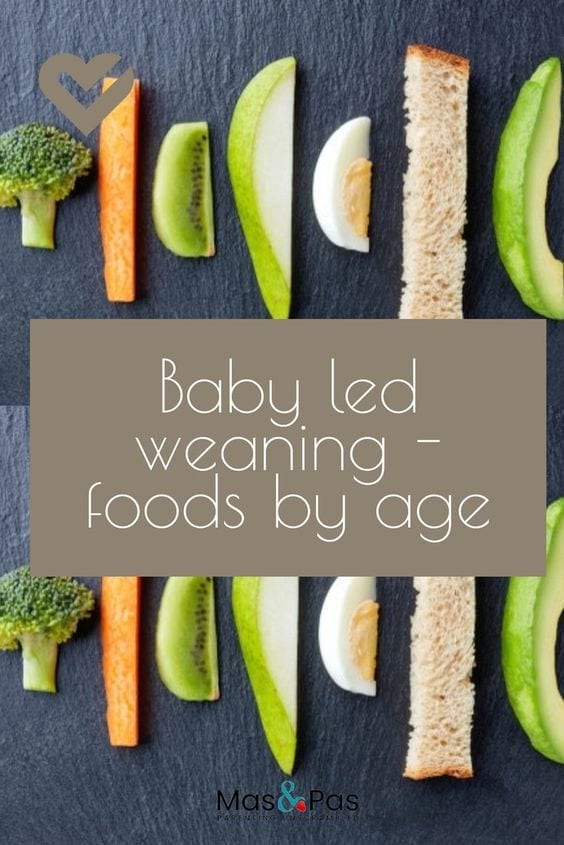
References
- Prevention of allergies and asthma in children, American Academy of Allergy, Asthma and Immunology
- Feeding in the first year of life, Scientific Advisory Committee on Nutrition
- Preventing food allergy in your baby: A summary for parents, bsaci
- Foods to avoid giving babies and young children, NHS
- Food allergies in babies and young children, NHS
- Your baby’s first solid foods, NHS

